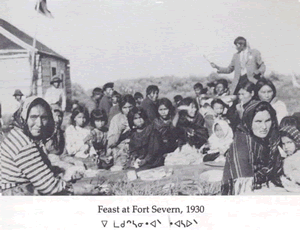| Fort
Severn has a long and complicated history. The fort itself began as a Hudson Bay
company outpost in 1756, almost two and a half centuries ago. In 1973, the community
moved from its historic location to the present one. The community is now located
about 850 km straight north of Thunder Bay (see map below). Two separate ecosystems
are present in the Fort Severn region, the first is the coastal area along Hudson
Bay, home to seals and whales. The second ecosystem is the lowlands, which are
home to the caribou that help to support the residents of Fort Severn. Polar bears
are another animal that can be found in these areas, living off seals and fish. |
click
on picture |  | Feast
at Fort Severn, taken in 1930 from "the Kayahna ... Occupancy Study"
published in 1985 |
| Fishing
was of extreme importance to this community in the past because of it's proximity
to large bodies of water. Until the 1960s fish was one of the main sources of
food for the sled dogs. Now the sled dogs that remain are still fed mostly fish,
although there are far fewer sled dogs then there were before the 1960s. Fish
also supplement the diets of most families during the winter, in the summer lakes
and rivers are too shallow to allow good fishing. Historically the main sources
of food have been caribou, which is still eaten regularly but is not the only
staple of the Fort Severn people's diet. Because this area is far more northern
then many other reserves, the climate is less populated by animals, therefor hunting
and trapping is far more spread out (see a map of trapping
areas used from 1925 to 1981). Hunting is also an important activity
for the people of Fort Severn. There are several animals important to the First
Nation as game for hunting, one such animal is the caribou. Ducks and geese are
also very important along the coast where there is no caribou (all of this can
be seen on the map of hunting areas used from 1925 to 1981). |





